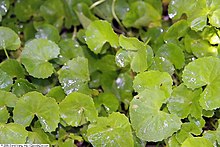| Bupleurum chinense | |
|---|---|

| |
| Scientific classification | |
| Kingdom: | Plantae |
| Clade: | Tracheophytes |
| Clade: | Angiosperms |
| Clade: | Eudicots |
| Clade: | Asterids |
| Order: | Apiales |
| Family: | Apiaceae |
| Genus: | Bupleurum |
| Species: | B. chinense
|
| Binomial name | |
| Bupleurum chinense | |
Bupleurum chinense (Chai Hu, Chinese: 柴胡; pinyin: chaí hú; Jyutping: caai4 wu4, Thorowax) is a plant of the family Apiaceae.
Distribution and appearance[edit]
Bupleurum chinense is native to East Asia. The leaves of the plant are long and thin and resemble fennel.
Use in traditional Chinese medicine[edit]
The root of B. chinense, known as Radix Bupleuri, is used in traditional Chinese medicine.[1] It has a large number of uses in Chinese medicine, including the application for liver issues.[2]
There is evidence that Chinese herbal medicines, including those derived from B. chinense, is potentially beneficial in treating fatty liver disease through a variety of different observed pathways. The safety of this particular herb is well established and known through several thousand years of use, and millions of patients who have taken this medicinal compound for different medical issues.[2][3]
Chemical constituents[edit]
Bupleurum chinense roots, also known as Radix Bupleuri, contain polyacetylenes and saponins/triterpenoids.[4]
References[edit]
- ^ Chinese Herbal Medicine: Formulas & Strategies. Eastland Press. 1990. ISBN 978-0-939616-10-7.[page needed]
- ^ a b Liu ZL, Xie LZ, Zhu J, Li GQ, Grant SJ, Liu JP (August 2013). "Herbal medicines for fatty liver diseases". Cochrane Database Syst Rev (8): CD009059. doi:10.1002/14651858.CD009059.pub2. PMID 23975682.
- ^ Zhao, Qianqian; Bai, Jinwei; Chen, Yiwei; Liu, Xin; Zhao, Shangfeng; Ling, Guixia; Jia, Shubing; Zhai, Fei; Xiang, Rongwu (2022-10-28). "An optimized herbal combination for the treatment of liver fibrosis: Hub genes, bioactive ingredients, and molecular mechanisms". Journal of Ethnopharmacology. 297: 115567. doi:10.1016/j.jep.2022.115567. ISSN 1872-7573. PMID 35870684.
- ^ Abe H, Sakaguchi M, Odashima S, Arichi S (September 1982). "Protective effect of saikosaponin-d isolated from Bupleurum falcatum L. on CCl4-induced liver injury in the rat". Naunyn-Schmiedeberg's Arch. Pharmacol. 320 (3): 266–71. doi:10.1007/BF00510139. PMID 7133157. S2CID 25691902.